Are you looking for a delicious culinary experience? Cilantro is an amazing herb that can add flavor to any dish, from tacos to salads. However, it must be harvested correctly in order to ensure quality and freshness. Knowing when and how to harvest cilantro can be the difference between an excellent dish or one marred by bitterness and mold. In this post we will cover the basics of harvesting cilantro so that you can get the best out of your crop! Read on for more information about knowing when and how to correctly harvest this tasty herb for maximum flavor!
What is Cilantro?
Cilantro is an herb that is part of the same plant family as parsley, celery and carrots. It has a very distinct flavor and aroma that many people find pleasant. The leaves are usually used fresh in cooking, while the dried seeds can be ground into a powder to use as a seasoning. Cilantro is widely used in Mexican, Latin American and Asian cuisine.
Nutritional Value of Cilantro
Cilantro is a popular herb that adds flavor to many dishes. It is also packed with nutrition! Cilantro is an excellent source of vitamins A, K, and C.

It also contains beneficial minerals such as manganese, iron, and calcium. The leaves are high in dietary fiber which helps your digestive system work properly and can aid in weight loss. Additionally, the herb has antioxidant properties which help protect against free radical damage caused by environmental toxins. Studies have shown cilantro may even have anti-inflammatory benefits due to its high concentration of polyphenols and flavonoids. Eating this tasty herb regularly can be extremely beneficial for overall health![1]
The Different Ways to Use Cilantro in Cooking
Cilantro is a flavorful herb that can be used in various dishes. It’s delicious when chopped into salads, soups and sauces. It also makes a great addition to Mexican and South American cuisines, adding color and flavor to tacos, salsas, burritos and enchiladas. Cilantro can even be chopped up with other herbs like parsley or mint for a fresh herbed pesto sauce or sprinkled over fish as an aromatic garnish. Of course, cilantro pairs perfectly with lime juice to make the popular combination for guacamole recipes. When it comes to harvesting cilantro, you have several options depending on how you plan on using it.
At this point, the stems are still tender and it will have the strongest flavor. To harvest, cut off the top one-third of each stem at its base just above where new leaves are growing.For using cilantro as a garnish or in smaller quantities, such as pesto sauce, wait until it is about two inches tall then use scissors to snip off what you need from the individual leaves. This way, you can use the same plant multiple times over a period of weeks without having to worry about it flowering and losing flavor.
When storing fresh cilantro, keep it in a sealed plastic bag and place it in the refrigerator. If you’re going to use it within a few days, try wrapping it loosely in damp paper towels and placing it in the crisper drawer. This will help maintain its flavor and freshness until ready for use.
When to Harvest Cilantro?
The best time to harvest cilantro is when the plant reaches 6–8 inches tall. At this stage, most of the leaves will have developed and there will be plenty of foliage for use. Once harvested, cilantro can be used almost immediately in recipes or dried for later use. To dry the herb, spread it out on a flat surface and allow it to air-dry for a few days until completely dry.
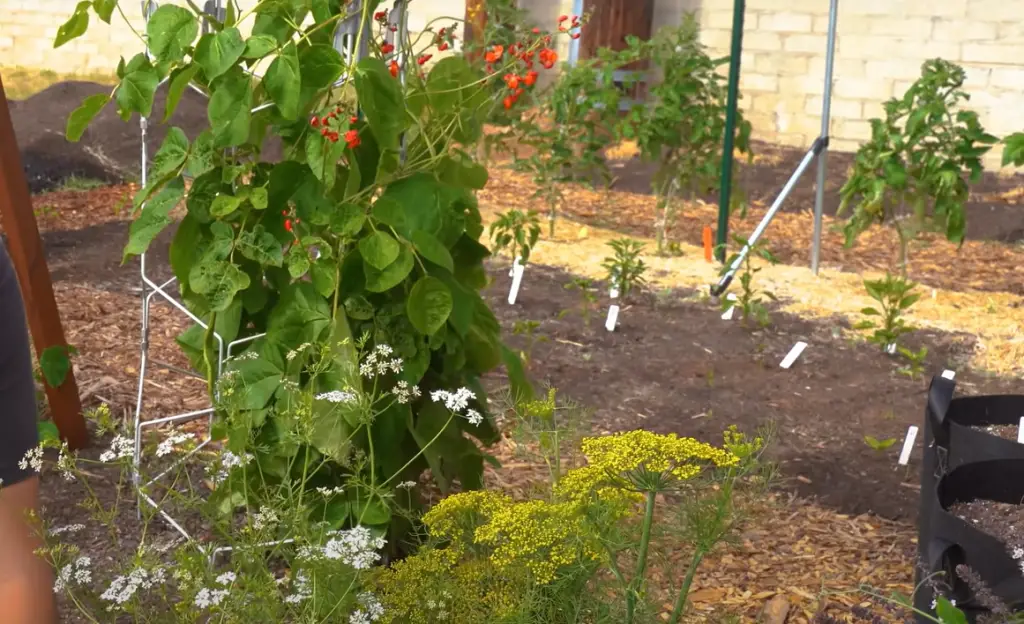
Dried cilantro should be stored in an airtight container away from direct sunlight to prevent it from losing its flavor. For optimal flavor, cilantro should be used within six months after drying. Enjoy fresh or dried cilantro in dishes such as salsa, guacamole, soups, salads and more!
Timing the Cilantro Harvest for Maximum Flavor and Nutrition
When harvesting cilantro, it’s important to pick at the right time for maximum flavor and nutrition. Generally, cilantro should be harvested when the plant is young and tender before the flowers begin to form. This typically happens between 60 to 90 days after planting or about 4-6 weeks after the leaves are fully grown. Once the flower buds start opening, you can still harvest some of these leaves but they won’t have as much flavor or nutritional value as leaves picked earlier in the season. To get continued harvests from one crop, cut off only a third of the stems each time you harvest. Overharvesting will cause stress to the plant and reduce yields later on. [2]
To keep your cilantro fresh, store it in the refrigerator and wrap the leaves or stems in a damp paper towel for up to 10 days. For longer storage, consider freezing or drying your cilantro. When dried, cilantro can last up to 6 months if stored in an airtight container away from heat and light. Cilantro also stores well chopped and frozen in ice cube trays filled with either water or olive oil.
When to Start Planting Cilantro Seeds or Seedlings for Optimum Growth and Yield
Cilantro is a delicious culinary herb that can be grown easily at home. If you’re looking for the best time to start planting cilantro seeds or seedlings for optimum growth and yield, the ideal season depends on your region and climate.
In general, in areas with milder climates (USDA hardiness zones 1–6), it’s best to start growing cilantro in early spring when there is still enough chill in the air. This gives the plant a chance to establish itself before temperatures get too warm. Planting late spring or early summer may result in bolting—when the plant starts producing flowers quickly due to warmer weather and days getting longer, which causes it to become bitter and unpalatable.
In areas with warmer climates (USDA hardiness zones 7–10), it’s best to plant cilantro in late summer or early fall when temperatures start to cool down. This way the plant will have time to grow without bolting and you can harvest cilantro leaves before winter sets in.
It’s important to note that cilantro is a short-lived annual herb, so regardless of your climate zone, it will only last for one season. Be sure to plan accordingly and sow new seeds several times during the growing season for continuous harvests!
How Long Does it Take to Grow a Plant from Seed to Maturity?
When growing cilantro from seed, it takes an average of 60 days for the plant to reach maturity and be ready for harvest. On the other hand, when using transplants, the plants can reach maturity in as little as 30 days. Growers should monitor their plants carefully during the entire growth period to determine the best time to begin harvesting. The leaves of a mature cilantro plant are bright green and develop a slightly coarse texture with serrated edges. Cilantro leaves become bitter when they start to flower so it’s important to harvest before this point.
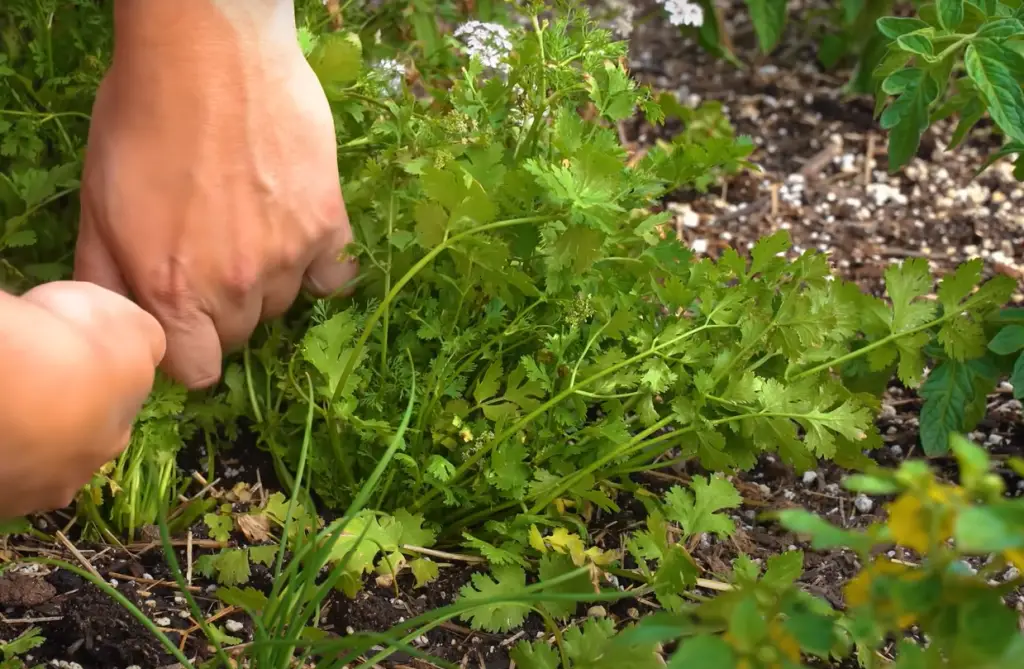
When harvesting cilantro by hand, cut off individual stems or bunches of several stems just above where new leaves are forming. If you’re looking for a more plentiful crop, it’s best to wait until the plant has developed several stems before harvesting. Additionally, it’s important to note that cilantro does not store well and should be used fresh soon after harvest.
With proper care and maintenance, a single planting of cilantro can provide multiple harvests throughout the growing season. [3]
Signs that Your Plants are Ready for Harvesting
When harvesting cilantro, look for the following signs that your plants are ready:
- The plant has reached full size and started to form flower buds – Cilantro grows best between temperatures of 60-75 degrees
- Fahrenheit and takes around 45-60 days from seed germination to maturity. When it starts forming flower buds, it is time to harvest.
- The leaves have become fragrant – If you notice that the leaves are becoming more aromatic with a strong yet pleasant smell, it is a sign that they are ripe and ready for picking.
- The stems turn hollow – Over time, cilantro’s stems will naturally start to hollow out as they reach maturity. This is an indication that it is time to begin harvesting them.
- The leaves start to curl – If the leaves start curling and wilting, this is a sign that the plant has gone beyond maturity and should be harvested immediately.
Harvesting cilantro at the right time can help you achieve maximum flavor and potency for your dishes! It is important to keep an eye on your plants so you know when it’s time to pick them for optimal taste. [4]
Different Methods of Preserving Cilantro for Long-Term Storage
Cilantro is a flavorful herb that can be used to add flavor to many dishes. It’s easy to grow and harvest in the home garden, but it doesn’t store well for long periods of time. For those who want to enjoy fresh cilantro all year round, there are several methods of preserving cilantro for long-term storage.
One way to preserve cilantro is by freezing it. Start by washing the leaves and patting them dry with paper towels. Then, spread them out on a baking sheet and place them in the freezer until they are frozen solid. Once frozen, transfer the leaves into an airtight container or resealable bag and return them to the freezer for up to 6 months. To use frozen cilantro, simply thaw it in the refrigerator for a few hours before chopping and adding to your favorite recipes.
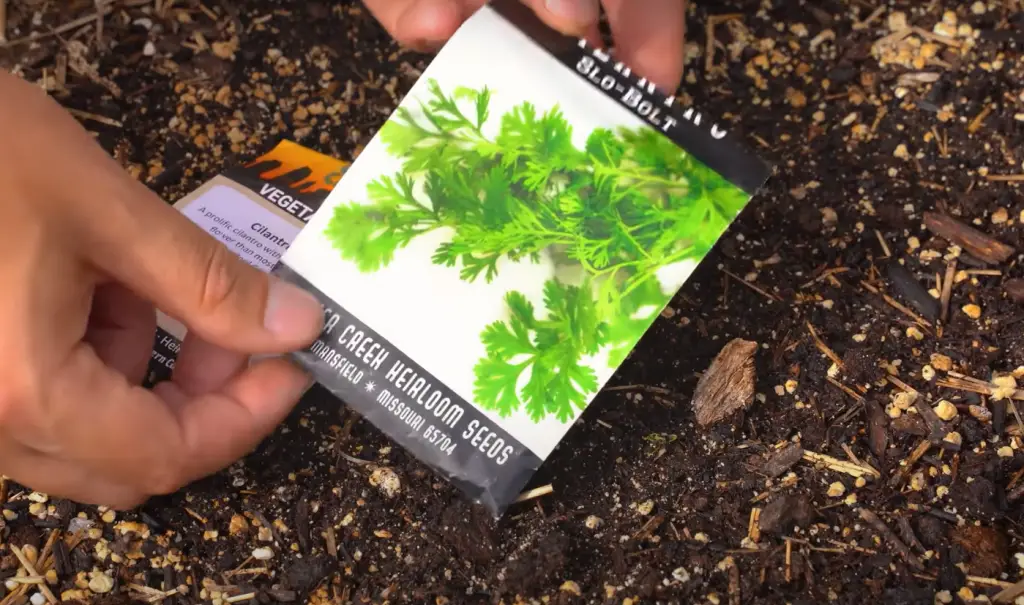
Another way to preserve fresh cilantro is by drying it. Start by washing and patting the leaves dry with paper towels.
Be sure to stir or rotate the leaves every 15 minutes to ensure even drying. Once dried, store the leaves in an airtight container away from heat and moisture for up to 6 months. To use dried cilantro, simply crumble it into small pieces and add to dishes as desired.For those who want an even longer shelf life, consider preserving cilantro by pickling or fermenting. Pickled cilantro can be made in a vinegar-based brine and stored for up to one year. Fermented cilantro is made with a saltwater brine solution and has the added benefit of probiotics. Fermented cilantro should be stored in the refrigerator and enjoyed within three months.
Working with Frozen or Dried Cilantro in Recipes
If you can’t harvest fresh cilantro, there are other options available. You can purchase frozen or dried cilantro to use in recipes. Frozen cilantro will last up to a year in the freezer and still retain much of its flavor.
When using dried cilantro, be sure to add it early during preparation so that it has time to soak up liquid and rehydrate before the food is served. Finally, be aware that the flavor of both frozen and dried cilantro tends to be slightly stronger than that of fresh-picked cilantro, so you may need to adjust your recipes accordingly. [5]When cooking with frozen or dried cilantro, it is important to remember that the flavor will not be as strong as if you were using fresh-picked cilantro. Therefore, use a bit more than the recipe calls for, adding a few extra pinches or tablespoons until it tastes right. Additionally, make sure to chop or mince the cilantro before freezing, so that it is easier to work with when defrosted and ready for use in recipes. When using dried cilantro, grind it up into a fine powder first to increase its surface area and allow for better absorption of liquid during cooking.
The Benefits of Growing Your Own Cilantro at Home
Growing your own cilantro at home is a great way to add fresh flavor and nutrition to your meals. Cilantro has many health benefits, including being rich in antioxidants, Vitamin K, and dietary fiber. It also helps reduce bad cholesterol levels and can be used as an anti-inflammatory. Harvesting cilantro can be done when the plant reaches 8-10 inches tall, or as soon as the plant starts flowering.
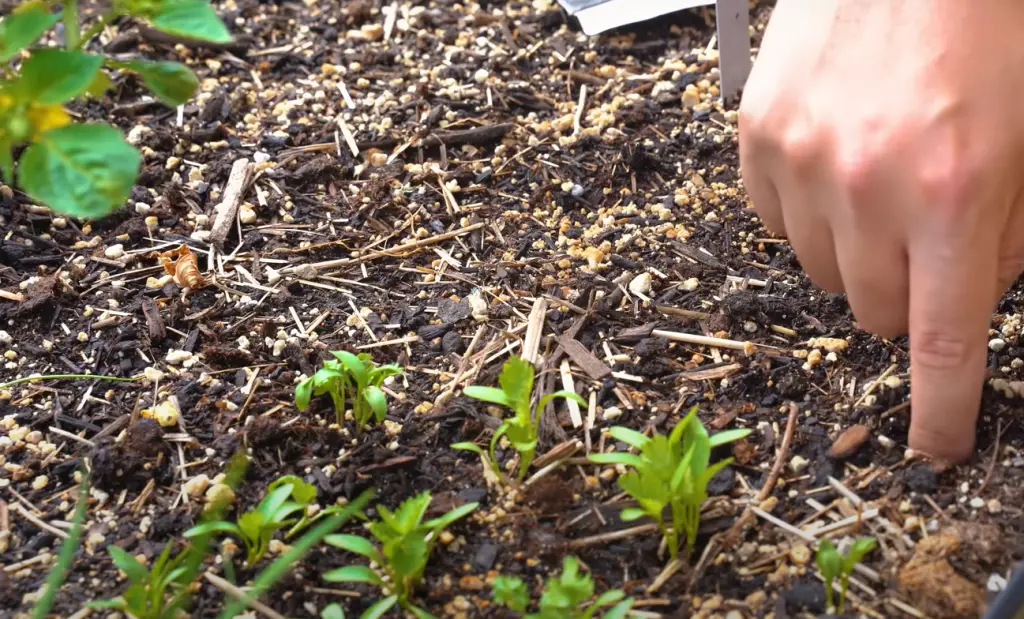
When harvesting cilantro, it’s important to cut just above the node (the area where a leaf attaches to the stem) so that you don’t damage the root system of the plant, allowing for new growth in future harvests. You may also want to harvest some of the leaves individually for use in recipes. Once the cilantro is harvested, you can use it right away or store it in an airtight container in your refrigerator. Growing and harvesting cilantro at home allows you to enjoy its fresh flavor and health benefits while saving money on grocery bills!
FAQ
Will cilantro grow back after cutting?
Yes! Cilantro is a resilient plant and will grow back after being harvested. In fact, if the cilantro is properly cared for it can be harvested multiple times throughout the season. However, once the cilantro reaches its peak maturity (typically around 4-6 weeks) it’s best to harvest the entire plant so it doesn’t become woody or bitter-tasting.
When should I harvest cilantro?
The best time to harvest cilantro is when the leaves are fresh and tender, usually just before they begin to flower. This typically happens about 4-6 weeks after planting. Although you can reap some benefits by harvesting earlier than this, as mentioned above, it’s best to wait until the fourth or sixth week in order to maximize flavor, texture, and nutritional value.
What should I do after harvesting cilantro?
After harvesting cilantro you can chop it up for immediate use or store it in a plastic bag in the refrigerator for later. If you plan to store your cilantro for an extended period of time, you should first blanch it (by boiling for 1-2 minutes) before freezing. This will help preserve its flavor and texture. You can also dry the leaves by spreading them onto a baking sheet and placing them in a warm oven (200°F) for 2-3 hours. Once dried, they can be stored in an airtight container at room temperature.
How do you harvest cilantro so it keeps growing?
Harvesting cilantro is easy – just snip off the top 2 to 3 inches of the plant. This encourages new growth and ensures a continuous harvest throughout the season. To maximize yields, it is best to wait until mid-to-late summer when the plants are well established before harvesting. It’s also important not to take too much at one time; remove no more than 1/3 of the total foliage from each plant per harvesting session. After harvesting, you can either refrigerate or hang dry your cilantro for future use. Refrigerating will keep it fresh for 7 days while hanging drying will preserve it longer (up to several months).
How often should I harvest my cilantro?
For optimum cilantro flavor and health, you should harvest your cilantro regularly. It is best to do this by snipping the stems with scissors when they reach 5-7 inches in length.
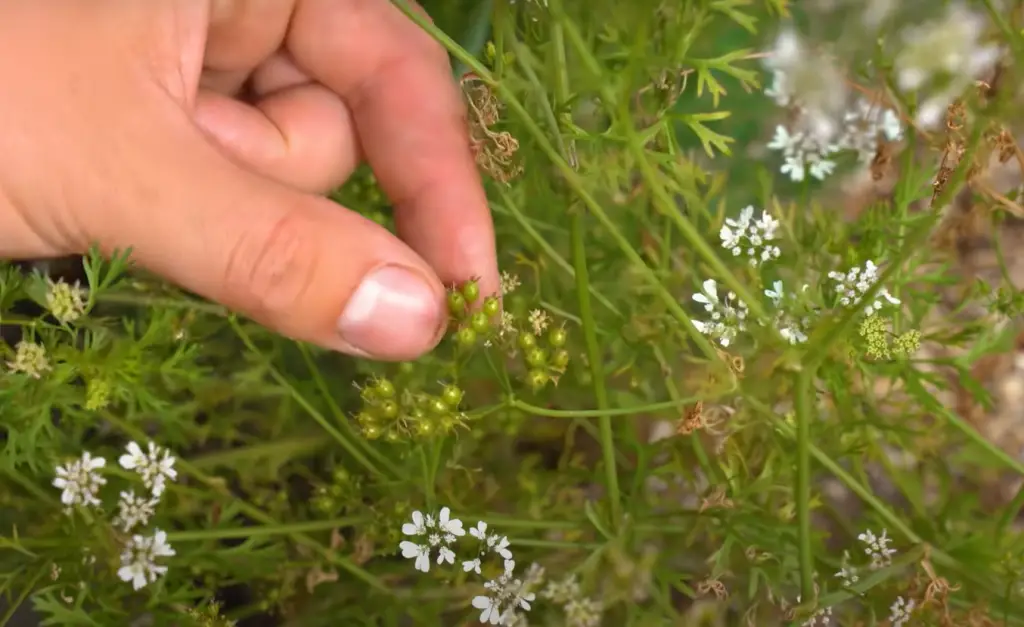
This allows for continuous growth while also ensuring that you get plenty of flavorful leaves. Additionally, harvesting cilantro frequently can help extend its season, as it will encourage more growth throughout the summer months. It is important not to wait too long before harvesting, as the plant may become woody and lose some of its flavor. Harvesting at least once a week is ideal for optimal cilantro production and flavor!
Can you pick cilantro after it flowers?
Yes, you can pick cilantro after it flowers. The plant will still be edible and flavorful—although the leaves may not be as tender as before flowering. Once the flowers open, you’ll notice that the flavor of the herb changes from sweet to more bitter. So if you want a sweeter tasting cilantro, be sure to harvest before flowers appear. Additionally, harvesting once your cilantro starts flowering can help extend its season by encouraging further growth.
Useful Video: How to Grow Cilantro…And Stop It From BOLTING!
Final Thoughts
When harvesting cilantro, it is important to remember to harvest before the flowers open. If you wait too long, your herb will not be as flavorful and may become bitter. Harvesting regularly also encourages new growth in the plant and keeps it healthy. Remember that harvesting cilantro can be done either by cutting off individual leaves or cutting off the entire stem at once. Have fun experimenting with different techniques to find what works best for you! Finally, don’t forget that cilantro does not keep very well, so make sure to use or freeze any extra in a timely manner. With a few simple steps, you can enjoy fresh cilantro all season long!
Happy harvesting!
References:
- https://www.wikihow.com/Harvest-Cilantro
- https://www.gardenerbasics.com/blog/harvesting-cilantro
- https://www.gardeningknowhow.com/edible/herbs/cilantro/how-to-harvest-cilantro.htm
- https://seedsheets.com/blogs/howto/how-to-harvest-cilantro
- https://www.epicgardening.com/how-to-harvest-cilantro/





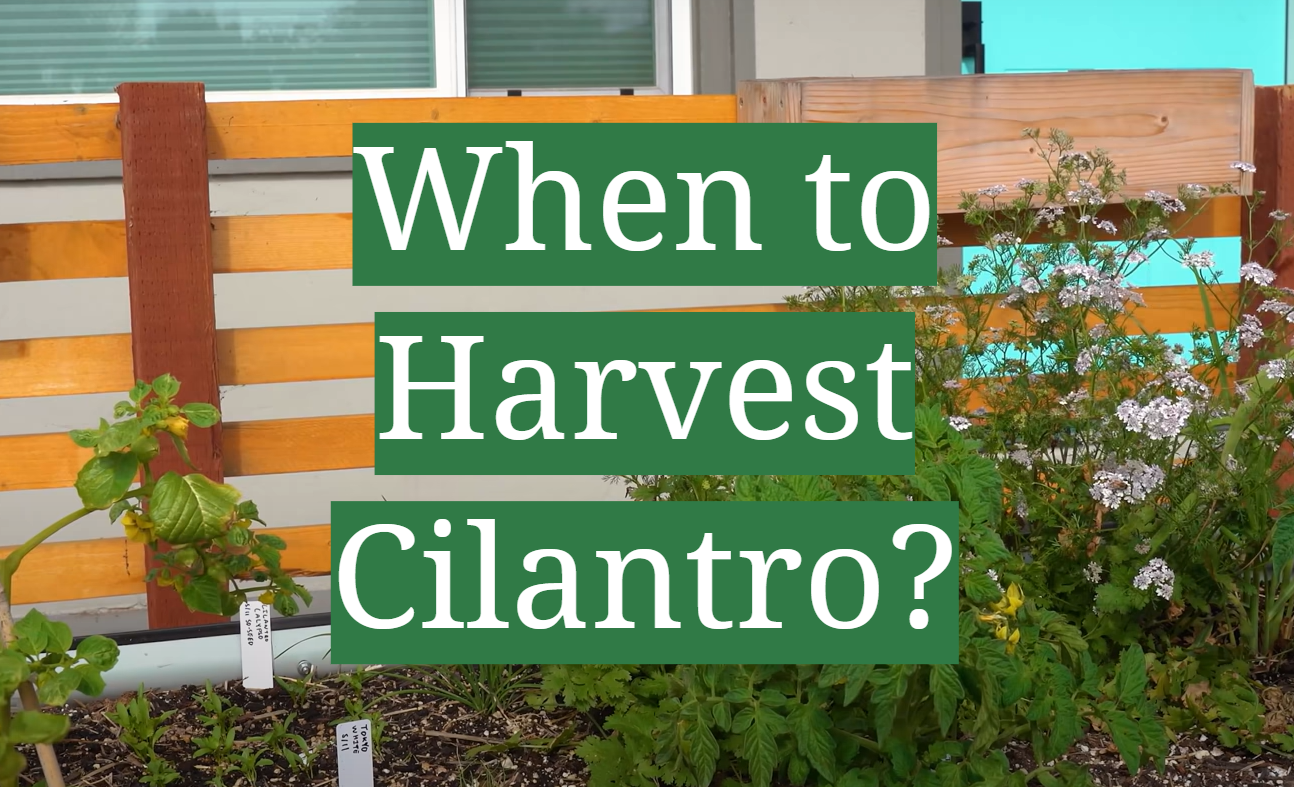




Leave a Reply
View Comments